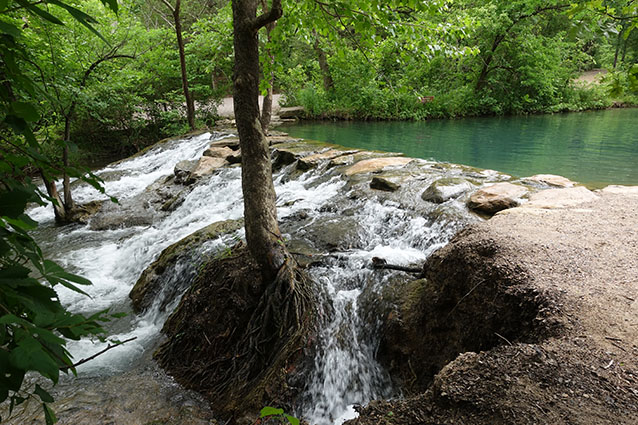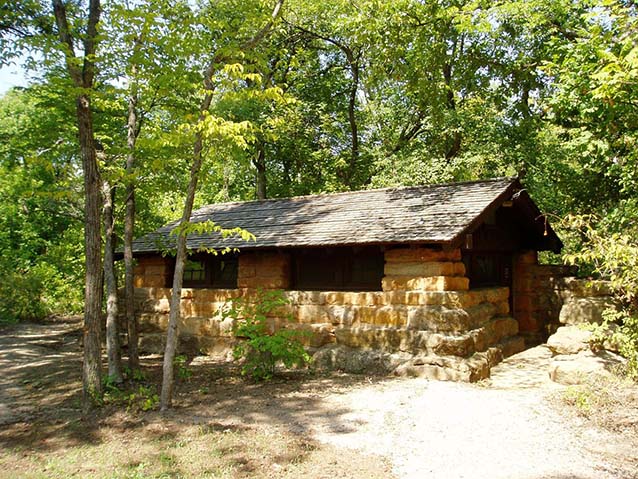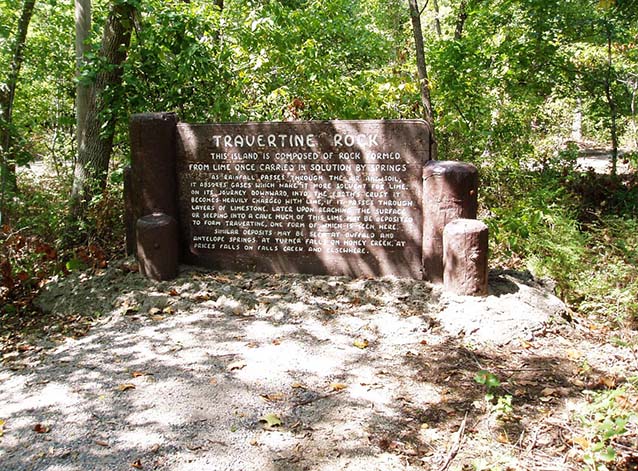The Little Niagara Falls and Travertine Island area is located in the northeastern portion of the Platt National Park National Historic Landmark District, part of Chickasaw National Recreation Area in Oklahoma. The landscape covers about 22 acres of wooded land with the Limestone and Travertine Creeks flowing through it, between Cold Springs Campground to the west and the Travertine Nature Center to the east.
In its site planning, style, and design, the area reflects the NPS principles of rustic design. The design of the waterways enhance the natural qualities of the site, and features like picnic areas and swimming holes contribute to the area's use.

NPS
The area contains numerous stone outcroppings, travertine formations, and natural and designed waterfalls. The focal point of the area is Little Niagara Falls and its associated swimming hole, beach, parking lot and comfort station.
Nearby is Travertine Island, which is primarily used as a picnic area. Travertine Island has its own associated parking lot and comfort station, as well as a designed picnic area with stone picnic tables and benches. Both areas are accessed from the park Perimeter Road, with the Little Niagara parking area accessed from the south portion of the loop and the Travertine Island lot accessed from the north portion of the loop. Both areas are primarily used for picnicking and swimming.

NPS / K. Ruhnke
Little Niagara Falls and Travertine Island area is significant for its association with the former Platt National Park (a National Historic Landmark District), which is now encompassed within Chickasaw National Recreation Area. The district is important for its association with the development of National Park landscapes completed during the Great Depression and funded as part of Franklin Delano Roosevelt’s “New Deal” programs.
The area is also significant as embodying the characteristics of the type, period, and methods of construction typical of the “rustic style” of park design developed by the National Park Service in the years between World War I and World War II (1916-1942) under the leadership of Thomas Vint. In general terms, Rustic park design limited development to preserve natural scenery and designed buildings and structures in harmony with the natural landscape. This meant using hand craftsmanship, local architectural styles and natural materials such as stone, wood, and native plants in the design of each park structure or element.

NPS / K. Ruhnke
As part of the larger district, Little Niagara Falls and Travertine Island exemplifies all of these aspects of National Park Service development, planning, and design. Although the area contains features dating to before 1930, the large majority of this landscape was constructed in the 1930s by Company 808 of the Civilian Conservation Corps (CCC).
The landscape features of Little Niagara Falls and Travertine Island also exhibit classic Rustic style design characteristics. The buildings and landscape features constructed by the CCC are made of local stone and wood, emphasize the horizontal lines of the landscape, and merge with their surroundings in color, scale, and appearance. Specifically, the design of the waterways and swimming holes enhance the natural qualities of the site, while the picnic areas contribute to the area's use and enjoyment. These elements exemplify the CCC-era landscape engineering projects undertaken in Platt National Park and throughout the country.
Quick Facts
- Cultural Landscape Type: Designed
- National Register Significance Level: National
- National Register Significance Criteria: A, C
- National Historic Landmark
- Period of Significance: 1933-1940
Landscape Links
Part of a series of articles titled Cultural Landscapes of Chickasaw National Recreation Area.
Last updated: December 30, 2019
